![]()
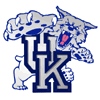 | 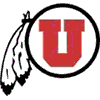 |
![]()
[Link to All-Time Series Results]
Kentucky and Utah have not met on the basketball many times (Kentucky leads the series 8-2), however the two schools are seemingly intertwined when it comes to the NCAA Tournament and have met many times in post-season competition. In fact, the two schools have only faced each other in tournament settings.
![]()
Game by Game Review
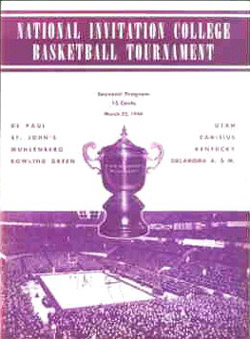 |
| 1944 NIT Game Program |
Kentucky was extremely young, with all the players freshmen except for two sophomores Tom Moseley and Wilbur Schu. Noted Kentucky head coach Adolph Rupp about the team which would come to be known as "The Beardless Wonders," "It's like running a kindergarten." The best player on the squad was freshman bruiser Bob Brannum, who would go on to be named Consensus All-American, at 17-1/2 years old, the youngest player to earn Consensus honors before or since.
Utah was just as young as Kentucky, with an average age of 18-1/2. Known as the "Blitz Kids," they were led by 6'7" freshman Arnold "Arnie" Ferrin, sophomore center Fred Sheffield and 5'8" point guard Wataru "Wat" Misaka.
The two teams were invited to the prestigious National Invitational Tournament in New York City. Kentucky was invited to the 8-team metropolitan tournament after a stellar 17-1 season which included winning the SEC regular and tournament titles. Utah, with an 18-3 regular season record, received bids to both the NIT and NCAA. But the Utes chose the NIT due to the better financial payout along with interest among the players and the coach in seeing the Big Apple, a prospect which was not guaranteed by participating in the NCAA. During that time, the NIT and the NCAA were both relatively new and with relatively small fields and no mandates requiring participation, each tournament attracted top teams to compete.
Asked before the game how he would match up agains the Ute's, Rupp noted that he had no contacts in the Salt Lake area to scout them so he didn't really know what his team would be facing in Utah. "They must be good" said Rupp, "or they wouldn't be here. That's the trouble; and we don't know what type of attack or defense to expect"
The game was close in the first half as Utah's Herb Wilkinson and Arnie Ferrin led Utah, while UK's Bob Brannum sat on the bench with three fouls after a little over seven minutes of playing. Brannum had been frustrated by the smaller, but high leaping Utah center Fred Sheffield. (Sheffield had been the NCAA champion high jumper in 1943 and would go on to place first or second nationally in the high jump each of his four years at Utah.) The score at the end of the half was 24-all, and the Utes proved to become the darlings of the crowd of over 16,000 in Madison Square Garden.
When Brannum returned in the second half, he teamed with Jack Parkinson and the Wildcats pulled away with a 46-38 victory. Parkinson would finish the game with a game-high 20 points on nine field goals while Brannum chipped in 11 points. Wilkinson led the Utes with 15 points while Arnie Ferrin added 13.
The Wildcats would follow up the game with a loss to the hometown St. Johns Redmen in the following game.
 |
| Utah's Fred Sheffield is sprawled on the floor but looks to pass to Wat Misaka as Jack Tingle contests |
[Boxscore] - 1943-44 - NIT First Round
Utah went on to be invited to the NCAA Tournament after Arkansas declined in light of a horrific automobile accident on a highway outside Fayetteville which involved the Razorback entire team. The station wagon the team was traveling in had a flat tire and with no shoulder alongside the highway, the car was parked in the right lane. As physical education instructor Eugene Norris and two players were fixing the flat, another car plowed into them, killing Norris and severely injuring Deno Nichols and Ben Jones, both Arkansas starters. Nichols' right leg was broken and was later amputated. Both of Jones' legs were broken and his back was fractured.
Utah heard the tragic news after they had already lost the Kentucky game, but were still in New York sightseeing. They were asked, and agreed to take Arkansas' place in the tournament field, which for them meant they needed to detour to Kansas City instead of returning directly to Utah. With two wins over Missouri and Iowa State in the NCAA's, the Utes found themselves once again back in New York City where they faced Dartmouth for the NCAA championship game. The Utes won the game 42-40 in an overtime thriller. Days later, they faced off against the NIT Champion, St. John's (the team which had defeated Kentucky in the NIT quarterfinals) in the annual Red Cross Benefit Game and won that game also.
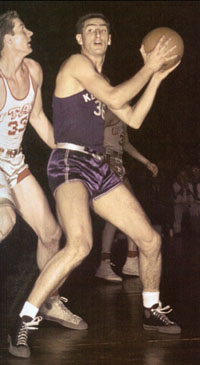 |
| Alex Groza works against Vern Gardner |
The Wildcats indeed has a formidable lineup, with many new stars such as aforementioned Beard and Jones to join established players such as Alex Groza and Bob Brannum who returned to Lexington after time serving in the armed forces. In fact, the Wildcat squad was so deep that year that Brannum and another former All-American, Jim Jordan struggled just to find playing time off the bench. Brannum was so frustrated he quit the team prior to them travelling to New York City to compete in the NIT. Nine players from the squad would end up playing in the NBA, a record which wouldn't be equalled by any other Kentucky squad until 1995-96 national title team.
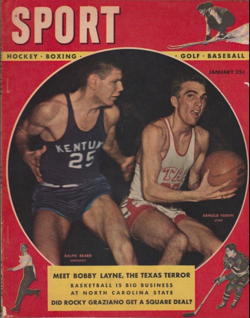 |
| Jim Line and Arnie Ferrin make the cover of SPORT Magazine (Note the UK player is erroneously said to be Ralph Beard) |
The game with Kentucky was a study in contrasts as Utah only substituted one man, Lyman Clark, who took the place of Fred Weidner at times. The other Utah players played the entire game. Meanwhile, Kentucky played nine men. The Utes played a ball-control offense, which stymied the Wildcat fast-break attack. Gardner and Ferrin provided the scoring for the Utes and controlled the boards while tiny Wat Misaka disrupted the Kentucky attack by holding high scoring Wildcat guard Ralph Beard to a single point.
The Wildcats trailed 27-21 at halftime and were faced with 7-point deficits three times in the contest. They rallied to within a point with just over three minutes remaining but Ferrin hit a layup and, after a Kentucky foul shot, Utah controlled the ball for the remainder of the game as time ran down. With a few ticks remaining on the clock, Ferrin found Gardner under the basket for an uncontested goal which gave Utah the final four-point victory margin, 49-45.
As in 1944, the Madison Square Garden crowd was solidly behind the boys from Utah. Ferrin and Gardner (both named All-Americans that year) each scored 15 ponts to pace Utah while Leon Watson added 13. Gardner was also named most valuable player of the tournament. Kentucky was led by Alex Groza (one of three All-Americans that year at Kentucky) and Jim Line, who each scored 12 points. This defeat would be the only thing holding this team back, from being considered one of the many great Kentucky teams of all-time.
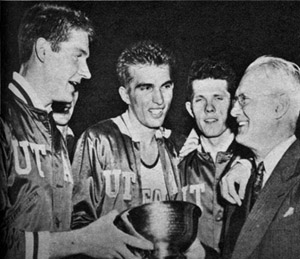 |
| Vern Gardner (left) accepts the NIT outstanding player trophy from John Coffey (right) |
Said Peterson after the game, "I believe I'm the happiest guy in the world. These kids wanted to win so much they took the fire right out of the Kentucky squad and played great ball. The kids have plenty of heart. and what pleased me and the boys was the way the fans pulled for us. They wanted us to win and showed they were pleased that we did. It was one of the greatest thrills I've ever had in my life."
[Boxscore] - 1946-47 - NIT Championship
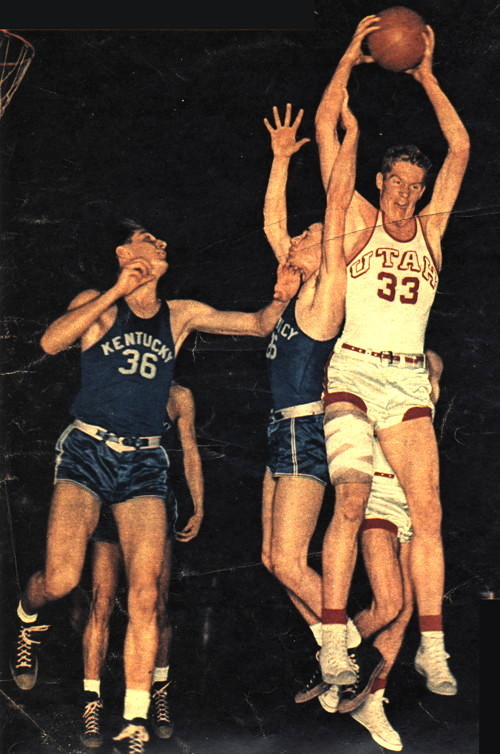 |
| Utah's Vern Gardner grabs a rebound over Ken Rollins while Alex Groza looks on |
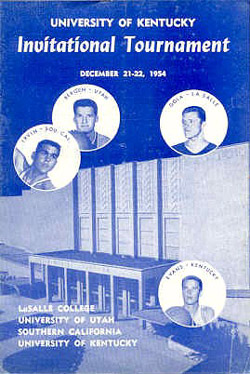 |
| 1954 UKIT Game Program |
Kentucky was facing a new beginning, as the core of their undefeated 1953-54 squad had graduated. To help off-set the losses of players like Cliff Hagan and Frank Ramsey, Kentucky signed Bob Burrow , a 6-7 center from Texas who had played previously at a Texas Junior College to go along with holdovers such as Billy Evans, Gayle Rose and Phil Grawemeyer among others.
Utah was also in the early stages of a transition, as Vadal Peterson had retired at the end of the 1953 season and he was replaced by Jack Gardner. The Utes were 7-0 entering the game and that day had jumped from #15 in the nation in the Associated Press poll to #2. (This was as high a ranking as any Utah team has ever achieved; the only other time Utah achieved such a high ranking was the final week of the 1996-97 season.) But standing in their way was 3-0 Kentucky, who was named the #1 team in the nation.
The game was a see-saw affair which saw Kentucky build an 11-point lead early but then Utah cut the margin down going into halftime, and the Utes early in the second half. Later, Utah built a seven-point lead but then it was the Wildcats turn to whittle down the lead. With three minutes remaining in the game and Utah clinging to a one-point lead, the Utes began to freeze the ball. An errant pass, however, was recovered by Kentucky and knotted the score on a free throw. Once again the Utes tried stall tactics but once again it backfired and the Wildcats regained possession on a turnover. Kentucky's Billy Evans proceeded to hit two free throws and later, after a Utah miss, Kentucky's Jerry Bird was left all alone under the basket and scored to seal the game.
After the game a happy Coach Rupp gave the ball to Bird and told him "It's yours." Asked by a writer after the game if the play which left Bird open was planned Rupp responded: Heck yes...we've been working on that play for five years."
Kentucky was led in scoring by Phil "Cookie" Grawemeyer with 27 points and Bob Burrow with 15. Utah was paced by center Art Bunte who 19 points. To add insult to injury, the Utes ended up losing the next night in the consolation game to Southern Cal after building a 15-point lead, only to see the Trojans fight back and eventually win the game in the final minute as Utah botched their attempts to freeze the ball. The Utes left Lexington with two losses, and saw their #2 ranking go up in smoke also as they dropped to #7 the following week.
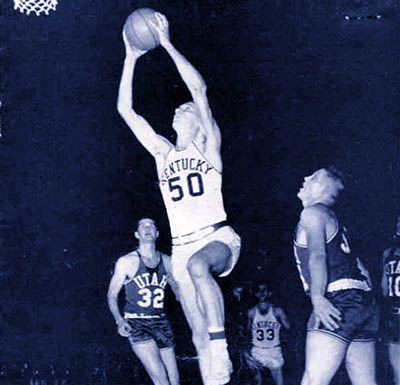 |
| Bob Burrow breaks free for a shot |
[Boxscore] - 1954-55 - UKIT
Over twenty years would go by before the two teams would meet again. (They almost met in the 1966 national title game in College Park, Maryland, however Utah was beaten in the semi-finals by Texas Western in a tight game.) The Utes once again entered the UKIT and once again met the home-standing Wildcats on the opening night. The game was held in newly built Rupp Arena where Kentucky had yet to be defeated in five attempts. The Wildcats were also ranked #3 in the country at the time, although they were somewhat shorthanded after three players, starters Mike Phillips and Jay Shidler along with Truman Claytor were all suspended for the game for training violations.
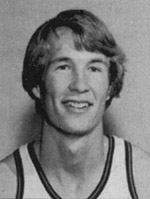 |
| Utah's Jeff Judkins |
Kentucky was led by Rick Robey who scored 19 points and grabbed eight rebounds. James Lee contributed 13 points and 13 rebounds in the losing cause. Utah's Jeff Judkins led all scorers with 24 points. Buster Matheney added 14 points and Jonas and Williams each contributed 10.
[Boxscore] - 1976-77 - UKIT
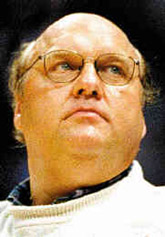 |
| Rick Majerus |
The first such encounter between the two teams was in 1993 in Nashville, TN in the second round of the NCAA Tournament. Kentucky was ranked #2 in the nation and was a #1 seed in the tournament. Utah was ranked #19 according to the Associated Press and as a #8 seed in the tournament field, had knocked off #9 seed Pittsburgh in the first round.
The game was not a contest, however, as Kentucky rolled to a 83-62 victory. The Wildcats held a 39-20 margin at halftime and cruised in the second half to the 21-point win. All-American Jamal Mashburn led the way with 19 points while six other players contributed seven or more points. Utah was led by Josh Grant with 24 points. Grant had come back from knee surgery and would finish his career that night as Utah's second leading scorer and rebounder in school history. Said Majerus of the Utes' season, "I don't want the Kentucky game to detract from the years we had. I told the team it was a great ride. We won the league co-championship, and we beat the other co-champion [Brigham Young] twice. We got to the NCAA Tournament, we won a game and we made it to the final 32. For what we had, we did well. The guys should be proud of what they accomplished."
As for Kentucky, the Wildcats would march on that year to the Final Four, where they came within an overtime of beating Michigan for a shot at the national title.
[Boxscore] - 1992-93 - NCAA Second Round
 |
| UK's Allen Edwards and Antoine Walker box in Utah's Keith Van Horn |
As many expected, the game was not much of a contest. The Utes were ranked #10 in the nation and received stellar individual performances from Keith Van Horn and Ben Caton, however it was not enough in the face of the swarming and deep Kentucky squad, The Wildcats raced to a 56-34 lead at halftime and never looked back, beating the Utes by a 31-point margin, 101-70. The Wildcats forced twenty-one Utah turnovers compared to six for Kentucky.
Antoine Walker led the way with 19 points and eight rebounds while Derek Anderson added 18. Tony Delk and Anthony Epps each contributed 14 points to the Wildcat's cause.
Utah was led by Keith Van Horn, who scored 23 points. Ben Caton shot an amazing 9-10 from the field, including 3 of 3 three-point field goals for 22 points, but it was not enough.
Said Coach Majerus after the game. "I'm really just shell-shocked right now. I'm punch-drunk, and pretty soon I'm probably going to be drunk. I'll probably have 10 fuzzy navels and call it a night. I'm not advocating alcohol abuse. I'm just worn out, depressed, stunned."
Kentucky went on to use their swarming defense to steamroll Wake Forest with Tim Duncan, and then proceeded to the Final Four where they settled a score against Massachusetts (who had beaten them earlier in the year) and eventually won the national title over Syracuse, the first time since 1978 the Wildcats brought the championship trophy back to Lexington
[Boxscore] - 1995-96 - NCAA Regional
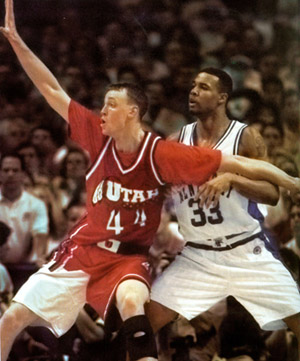 |
| Two All-Americans: Ron Mercer checks Utah's Keith Van Horn |
Kentucky lost four players from the 1996 team to the NBA, but were still a very potent team. The team originally revolved around the tandem of Ron Mercer and senior Derek Anderson before Anderson injured his knee in a mid-season game. Despite the setback, the Wildcats were able to regroup and were ranked #5 in the nation by the Associated Press at the end of the regular season.
If there ever was a time for Utah to make a statement against UK, this was their chance, especially since Kentucky had been awarded with the #1 seed by the NCAA Tournament committee instead of Utah, despite the Utes' higher ranking. Said a confident Keith Van Horn about Kentucky, "They are not the team they were last year. And neither are we." It is noteworthy that before the two teams were to meet in the regional finals, the Wildcats first had to win their first and second round games which were hosted by Utah in the Huntsman Center.
The fact that Utah was higher ranked didn't appear to faze the Wildcats, who once again ran over the Utes en route to another Final Four appearance. The Utes made a game of it when they came back from a ten-point halftime deficit. A three-pointer by Drew Hansen tied the score at 43-all with just under ten minutes remaining. But Kentucky went back in the lead and an injury to Utah guard Andre Miller's hand sealed their fate. The final score was 72-59.
Mercer led the way for Kentucky with 21 points while Epps added 15 points, Wayne Turner 12 and Scott Padgett added 11. Keith Van Horn was held to 15 points, with Doleac and Miller the other Utes in double figures with 13 and 11 points respectively.
The outcome was a tremendous set-back for the Utes, who no doubt saw a chance for the team to return to the former glory of the 40's, as they saw their dreams crushed once again. This was only the second time Utah had been ranked #2 in their history (Utah has never been ranked #1), and both times, they were beaten by the Wildcats of Kentucky.
Keith Van Horn was named a consensus All-American that year and finished his 4-year career as Utah's all-time leading scorer with over 2500 points. After his final game, and looking back on his remarkable career at Utah, Van Horn was quoted as saying "I just want to remember the good things that happened." Kentucky's Ron Mercer also was named a consensus All-American that year, and opted to forego his college eligibility by entering the NBA draft after his sophomore year.
[Boxscore] - 1996-97 - NCAA Regional Finals
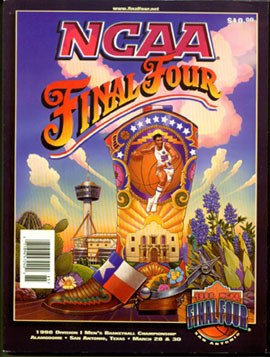 |
| 1998 NCAA Championship Program |
Kentucky was an unlikely winner of their regional, having beaten Duke in dramatic fashion in the regional finals and then coming from behind to beat Stanford in the national semifinals. Quickly becoming known as 'The Comeback Cats', this group of Wildcats were largely the reserves of previous Kentucky juggernauts who now were afforded their own chance to shine. The coach of Kentucky was "Tubby" Smith, who was in his first year at the helm after Rick Pitino left Lexington for the riches of the NBA's Boston Celtics.
 |
| Jeff Sheppard eyes the basket |
As the second half began, Utah scored to go ahead by 12 points, their largest lead of the game. But the Cats slowly cut the margin down throughout the half, with Coach Smith continuing to substitue liberally as he had done in previous games. At the ten minute mark, Utah held a seven-point lead 58-51, but the Wildcats then went on a spurt to tie the game. After a short timeout, Kentucky's Jeff Sheppard stole the ball and dunked to give UK their first lead of the second half. The game was tight with the lead changing hands for the next few minutes, but as the game clock ticked down, the Utes became more visibly fatigued and it showed in their play. Kentucky held Utah to only four field goals in the final 16 minutes of play. By the end of the game, Kentucky has turned what was a 10-point halftime deficit into a nine-point margin of victory.
Kentucky was led by Scott Padgett with 17 points and Sheppard with 16. Heshimu Evans and Nazr Mohammed were also key contributors with 10 points apiece. Kentucky's reserves outscored Utah's by a margin of 25-7. Noted Wall Street Journal sportswriter Frederick C. Klein, "Kentucky owed its championship to depth and the unflashy labor that goes into a wear-'em-down defense."
Utah enjoyed very balanced scoring with Andre Miller leading the way with 16 points, Michael Doleac and Hanno Mottola each contributing 15 points (along with 10 and eight rebounds respectively) and Alex Jensen adding 14 points.
Said Utah freshman Britton Johnsen after the game, "It's a horrible feeling right now. Coach (Majerus) told us he doesn't think we're the No. 2 team in the country. He feels like we're the No. 1-A team." Sighed Utah assistant Jeff Judkins after the Wildcats third NCAA victory over Utah in three consecutive years (and fourth in six years), "They just have our number I guess. Just like we've got Colorado State's number."
This was Kentucky's second national championship in three years, and their third straight appearance in the title game, despite the fact that each team's key players were different from the others. Jeff Sheppard was named most outstanding player in the Final Four, while UK's Scott Padgett and Utah's Michael Doleac and Andre Miller were also named to the all-tournament team.
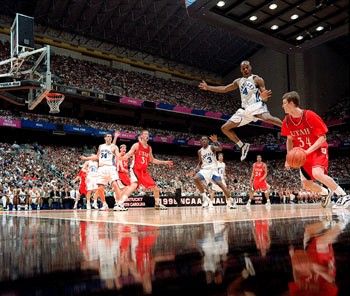 |
| Heshimu Evans flies in to defend |
[Boxscore] - 1997-98 - NCAA Championship
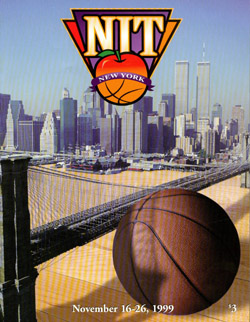 |
| 1998 NCAA Championship Program |
The two teams were both young and fairly evenly matched, with Kentucky ranked 14th in the nation and Utah 16th by the Associated Press. Utah led in the first half before the Wildcats went on a 11-0 run and went on to hold a five point lead at half, 31-26.
The second half was tight throughout and was close in the closing minutes. However, Kentucky's Tayshaun Prince made a number of key plays late in the game to secure the victory. By grabbing key rebounds, hitting clutch shots and free throws and blocking Utah's shot attempts, Prince gave Kentucky the edge. The game was sealed with Kentucky leading 54-48 with time winding down. Utah's Alex Jensen attempted a three-point shot which was blocked by Kentucky center Jamaal Magloire (a block which tied Magloire with UK great Sam Bowie as the all-time career blocks leader at UK) and recovered by Prince. Prince sank the pair of free throws to give Kentucky a six-point cushion and the final victory margin.
Magloire led Kentucky with 15 points while Prince added 11. Utah was paced by Jeremy Killion with 15 points to go along with 10 points each from Tony Harvey and Alex Jensen.
[Boxscore] - 1999-00
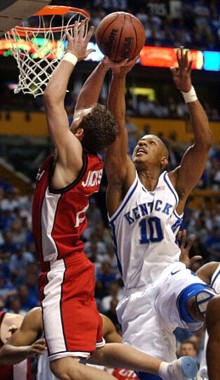 |
| Keith Bogans defends against Utah's Marc Jackson |
Utah squeaked past Oregon in the first round, 60-58, only to face their old nemesis in the second round. As with some of the earlier NCAA game, the Wildcats breezed over the Utes. Utah chose to guard Kentucky center Marquis Estill one-on-one with either of their two seven-foot centers, Tim Frost or Cameron Koford, and stay home (and hopefully clamp down) on the Kentucky guards. Unfortunately for Utah, Estill took advantage of the situation, scoring 10 points and grabbing six rebounds in the first half. Remarked Cliff Hawkins, "I guess they figured they were better off with their big guys. If they let 'Quis get off, they'd be ok. Basically (for us), it was just get the ball to 'Quis and get out of the way."
Kentucky built a 14-point halftime lead. Utah closed the margin to nine with nearly 11 minutes remaining in the game, but Kentucky Coach "Tubby" Smith called a time-out and Kentucky promptly went on a 11-4 run. The final margin was 20 points, at 74-54.
Estill and Keith Bogans paced the Wildcats with 18 points each while Hawkins added 13 and Chuck Hayes 10. Marc Jackson was the high scorer for Utah with 19 points followed by Nick Jacobson with 14.
[Boxscore] - 2002-03 - NCAA Second Round
Even after the string of stinging defeats in the late 1990's, including the national title game, the two programs more times than not continued to be placed in the same region by the NCAA committee. The pairing was less a concern for Kentucky fans as they saw the event of a contest against the Utes as a good omen. Said Rick Majerus in 2000, "I am like Kentucky's favorite punching bag. People in Kentucky love me. I'd like me too if I lost every game." Noted Kurt Kragthorpe of the Salt Lake Tribune in an article on the one-sided rivalry in 2005 "Yet the good people of the Commonwealth are not terribly smug about their domination of Utah. A little condescending, maybe, but not cruel. They look at the Utes as historically harmless, but noble and lovable in advance of Friday's Sweet 16 pairing at Austin, Texas. They expect to beat the Utes, pat them on the heads again and get ready for Duke."
For Utah fans, the seemingly annual pairing with UK is anything but funny. If it is a joke, it's of the twisted and cruel variety. Noted Utah athletic direct Chris Hill (and member of the NCAA selection committee) after Utah was paired once again in the same bracket with Kentucky in the 2005 tournament. "It's hysterical; People think we plan this, but I didn't even notice it until later. You would think someone would have said, - 'Oh, look, you're playing Kentucky again,' but there was not a word said about it. It is odd."
For former Utah players, the mere mention of Kentucky brings up painful memories. Said Mark Rydalch of being on the losing end of games in 1993 and 1996, "To be honest with you, those [games] evoke a lot of bad memories. I've kind of tried to block them out." Noted Utah alum (and former Wildcat victim) Michael Doleac on the impending Utah-Kentucky matchup in 2005 and asked about Utah's chances, "Nothing would make me happier than beating up on Kentucky. I'd love to see them (the Wildcats) lose ... I always have a special place in my heart when Kentucky loses to anybody."
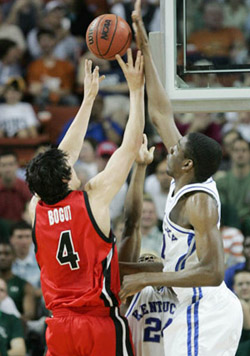 |
| Shagari Alleyne swats a shot from Andrew Bogut |
If Utah felt optimistic about the game, they had reason to. It was Utah which boasted the best big man in the nation, Australian center Andrew Bogut to go along with a tough and seasoned supporting cast. Prior to the game, Bogut not only appeared unimpressed by Kentucky and their depth in the front-court, but boasted that he would "punish" the Wildcats with his physical style of play. Given the advantage at center, the generous (to Utah) location of the game and the fact that UK was inconsistent at time during the season, many Ute fans saw the Wildcats ripe for an upset.
The game was a physical one, and Bogut made good on his threat, but Kentucky's big men didn't back down for long. While Kentucky's starting center, freshman Randolph Morris, got into early foul trouble and had to leave the game, reserves Shagari Alleyne (7' 3") and Lukasz Obrzut (7') came off the bench and made life difficult for the big Aussie. Likely not used to facing the type of size he faced against UK in the regular season, Bogut worked extremely hard for every shot and rebound. Said Kentucky forward Bobby Perry, "His whole demeanor seemed frustrated. The game plan was to be physical with him and not let them get their cuts. I don't think any other team in the nation has the combination we can throw at people. Woo and Shagari did a tremendous job guarding an All-American. You could tell we frustrated him by the way he was talking to his team."
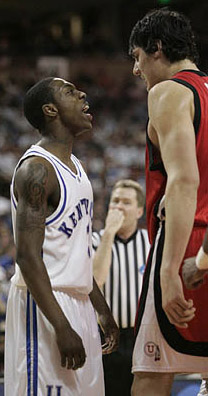 |
| Ramel Bradley and Andrew Bogut meet face-to-face |
Meanwhile, Kentucky more than matched Utah's physical style of play and held a workable margin throughout the game. Although the Utes made a number of runs to get back into the game, the Wildcats responded each time and continued to wear down the Utah starters, most of whom played significant minutes. The final score was 62-52. Kentucky was led by Chuck Hayes with 12 points and Rajon Rondo with 10, but it was the defensive of work of Alleyne and Obrzut that was the key, especially since UK's starting center Morris sat out most of the game in foul trouble.
Utah was led by Bogut, who scored 20 points on 8-19 shooting with 12 rebounds. Particularly damaging, however, was his poor 4-11 shooting at the free throw line. Senior guard Marc Jackson added 10 points for the Utes while Bryant Markson added nine.
[Boxscore] - 2004-05 - NCAA Sweet Sixteen
![]()
Since 1993, Kentucky and Utah have been placed in the same bracket eight of the eleven times Utah has received an NCAA bid (Kentucky has been invited to the tournament each year since that time.) One of the times the two were not in the same bracket, they met in the national championship game in 1998. Three of the eight years, Utah lost in an earlier round which prevented the matchup. Below are the details.
| Year | Kentucky Placement (Utah Placement) | Result of Matchup |
|---|---|---|
| 1993 | #1 Seed Southeast (#8 Seed Southeast) | Kentucky beats Utah, 83-62, in second round |
| 1994 | #3 Seed Southeast (No NCAA Bid) | - |
| 1995 | #1 Seed Southeast (#4 Seed West) | - |
| 1996 | #1 Seed Midwest (#4 Seed Midwest) | Kentucky beats Utah, 101-70, in Sweet 16 |
| 1997 | #1 Seed West (#2 Seed West) | Kentucky beats Utah, 72-59, in Elite Eight |
| 1998 | #2 Seed South (#3 Seed West) | Kentucky beats Utah, 78-69, in national championship |
| 1999 | #3 Seed Midwest (#2 Seed Midwest) | No matchup - Utah is upset in second round by Miami (OH) |
| 2000 | #5 Seed Midwest (#8 Seed Midwest) | No matchup - Utah is beaten in second round by Michigan State |
| 2001 | #2 Seed East (No NCAA bid) | - |
| 2002 | #4 Seed East (#12 Seed South) | - |
| 2003 | #1 Seed Midwest (#9 Seed Midwest) | Kentucky beats Utah, 74-54, in second round |
| 2004 | #1 Seed St. Louis (#11 Seed St. Louis) | No matchup - Utah is beaten in first round by Boston College |
| 2005 | #2 Seed Austin (#6 Seed Austin) | Kentucky beats Utah, 62-52, in Sweet Sixteen |
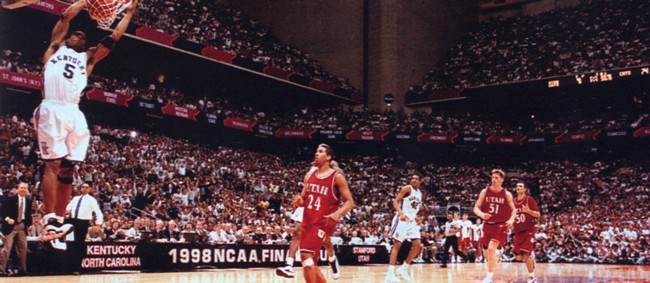 |
| Wayne Turner beats the Utah team down the court for a dunk |
![]()
Please note that the following reference materials were consulted for the above. 1.) Runnin' Utes Basketball Greatest Moments compiled by Terri Ellefsen 2.) Utah Basketball Media Guide 3.) The Rupp Years by Tev Laudeman 4.) Big Blue Machine by Russell Rice 5.) Inside Sports College Basketball by Mike Douchant 6.) The Winning Tradition by Bert Nelli 7.) "Kentucky curse still haunts ex-Utes," by Steve Luhm, The Salt Lake Tribune March 25, 2005 8.) "Utah vs. Kentucky becoming the norm," by Doug Robinson, deseretnews.com March 25, 2005 9.) Sports Illustrated 1996 Kentucky Special Edition among others.
Return to Kentucky Rivalries, Utah Series Results, statistics, teams, opponents, players, coaches, opposing coaches, games or search this site.
Page written by Jon Scott. Please with any corrections or additional information.
Last Updated July 3, 2005